Léon Spilliaert, a Troubled and Troubling Painter
From 23 February, the Royal Academy of Arts will present the first major exhibition of Flemish artist Léon Spilliaert (1881–1946) to be held in the UK. Bringing together around 80 works drawn from public and private collections across Belgium, France, Great Britain and the USA, the exhibition will offer a rare opportunity to discover this intriguing, singular artist who left an indelible mark on the twentieth-century art of Belgium.
Lenin is said to have hung a painting by the Flemish painter Leon Spilliaert (1881-1946) in his room in Spiegelgasse when he lived in Zurich. Unfortunately we do not know which. Although Spilliaert had a number of faithful admirers apart from Lenin, including the great Belgian poet Emile Verhaeren, in his lifetime he was not generally considered to be a major painter. Thus his Brussels dealer, Walter Schwarzenberg, exhibited Spilliaert in his second rather than his main gallery. As Jean Milo, who worked for Schwarzenberg, commented: ‘Spilliaert was considered a “minor master” at the time and we preferred the big tenors’. It was only in the late 1960s and early 1970s, with the revival of interest in non-Impressionist art from around 1900, that Spilliaert’s reputation started to take off, although, at the international level, it still lags far behind his real stature.
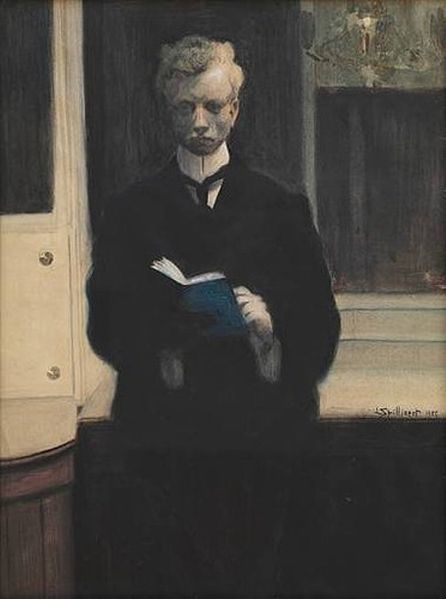 Self-portrait with a Blue Sketchbook, 1907, Royal Museum of Fine Arts, Antwerp
Self-portrait with a Blue Sketchbook, 1907, Royal Museum of Fine Arts, Antwerp© Wikimedia Commons
The son of an Ostend hairdresser and perfumer, Spilliaert’s art was strongly affected by his native town and its seaside setting. He suffered from a stomach ulcer, which made him an insomniac and led him to become a nightwalker. His nocturnal visions of Ostend are among his most gripping works. What are the characteristics of these and other types of painting done by Spilliaert? What made him different, special?
First, his colour. Spilliaert used few colours in any one painting, using subtle tonal gradations rather than rich harmonies. He often used dark colours – black and grey were his favourites – and they were clashing, acidic and harsh rather than voluptuous. His use of colour was not so much descriptive as decorative and expressive.
Second, Spilliaert was a masterly draughtsman. In his painting he used line in an economical but telling way, often not as a separate pictorial element but as a boundary defining shapes expressed as areas of colour.
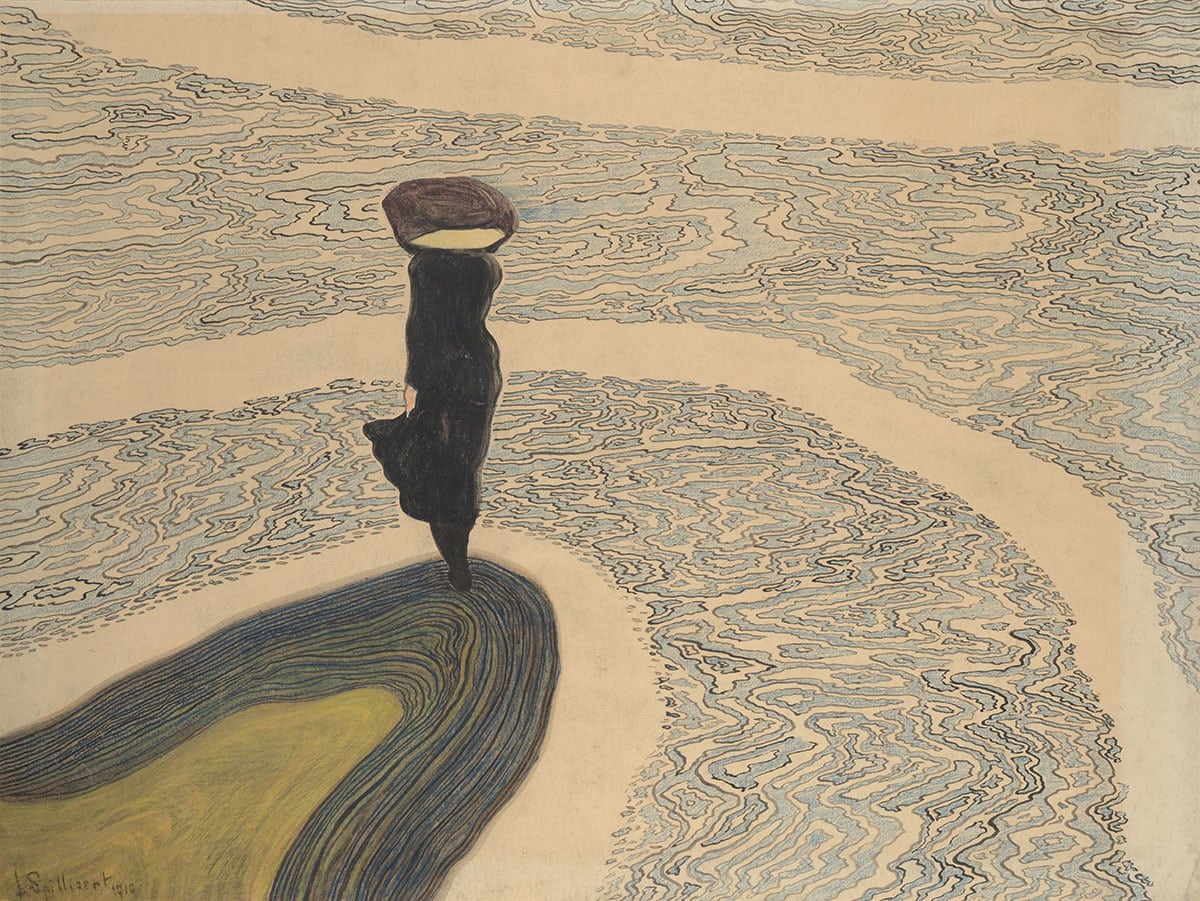 Woman at the Shoreline, 1910, Private collection
Woman at the Shoreline, 1910, Private collectionPhoto: © Cedric Verhelst
Third, Spilliaert’s handling of what we could call ‘compositional space’ was strikingly original. His beaches, sea walls and steps are given an extreme – even an exaggerated – geometrical interpretation that confers on them an abstract rather than a representational quality. As Francine-Claire Legrand observed: ‘While Spilliaert’s paintings may not have been large, his vision was. He discarded details to create the monumental on a small scale. This feeling for synthesis led him to quite new perspectival solutions of pioneering significance in the development of abstract art. Not until Mondrian do we find a similarly daring use of space.’
Of course, Spilliaert was not a ‘man from nowhere’. There were influences on his work, but they were no more than that – influences. He forged his own style out of a strange inner vision. So, he was touched by Toulouse-Lautrec’s line, by the flat coloured areas of the Nabis, by the velvety blacks of Odilon Redon, by Art Nouveau patterning, by the fin-de-siecle emotions of Symbolism, and so on. But if those and other influences touched his art, they did not mould it. He absorbed them and used them for his own purposes, remaining a ‘loner’ or ‘outsider’, refusing to identify himself with any particular movement or ‘-ism’.
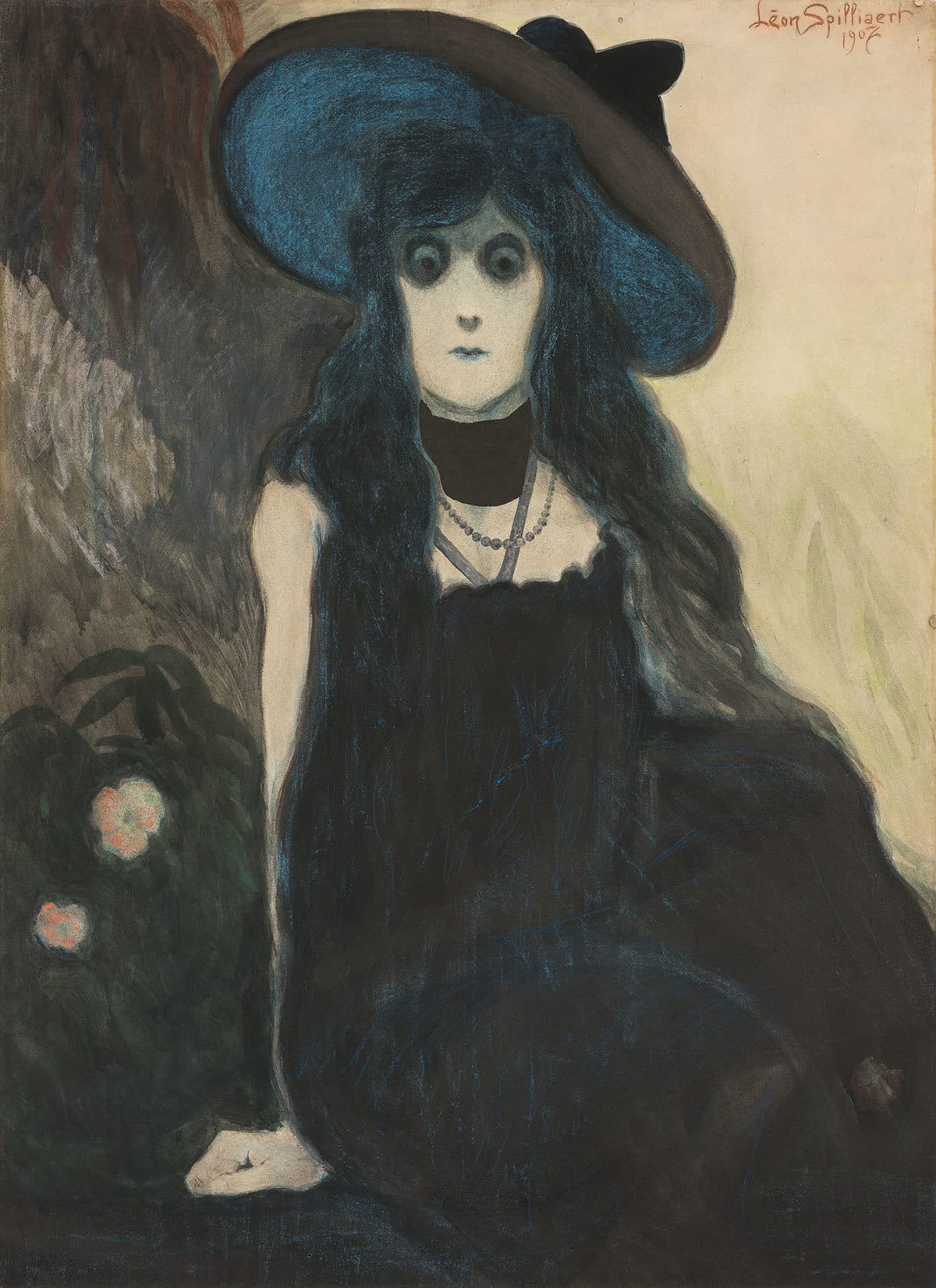 The Absinthe Drinker, 1907, Collection King Baudouin Foundation, entrusted to the Fine Arts Museum of Ghent, Belgium
The Absinthe Drinker, 1907, Collection King Baudouin Foundation, entrusted to the Fine Arts Museum of Ghent, Belgium© Studio Philippe de Formanoir
For Spilliaert the subject of a picture was not of the highest interest. His concern was the making of the picture: how to compose it, how to balance its elements. Starting with a well-defined visual idea, he would play with it in his mind until he executed his fully worked out composition on paper or cardboard. On those materials, not canvas, because he worked almost always with pastel, water-colour, wash or ink, which he preferred to oil because these media lend themselves to transparency and spontaneity of handling.
Nonetheless, Spilliaert did have a number of preferred themes, including self-portraits, solitary figures, Ostend, the sea and the seaside, interiors and trees.
That Spilliaert’s paintings more than those of most other artists were landscapes of his emotions is most apparent in his self-portraits. These disturbed and disturbing pictures, mostly painted in 1907 and 1908, are among the most searching scrutinies of Self ever recorded. The artist’s strange face, with its dark-ringed protuberant eyes and faint moustache, surmounted by quiffed hair, recurs not just once in each self-portrait but sometimes several times over, reflected in a mirror or series of mirrors that multiply the image, which is often imprisoned in a geometric setting. These brutally candid self-portraits, carried out in predominantly dark colours, pose the questions: who am I? where do I come from? where am I going? No answer comes.
One of these paintings depicts the leaf of a calendar on which the number 2 is boldly printed. This has been thought to be a reference to the day of the dead, All Souls’ Day, the second of November. Did Spilliaert fix each self-image as a step on the path leading to death? How different is this obsessive self-regard from the traditional self-portrait, carried down from Renaissance times, of the dapper, confident young painter looking at us nonchalantly over his palette.
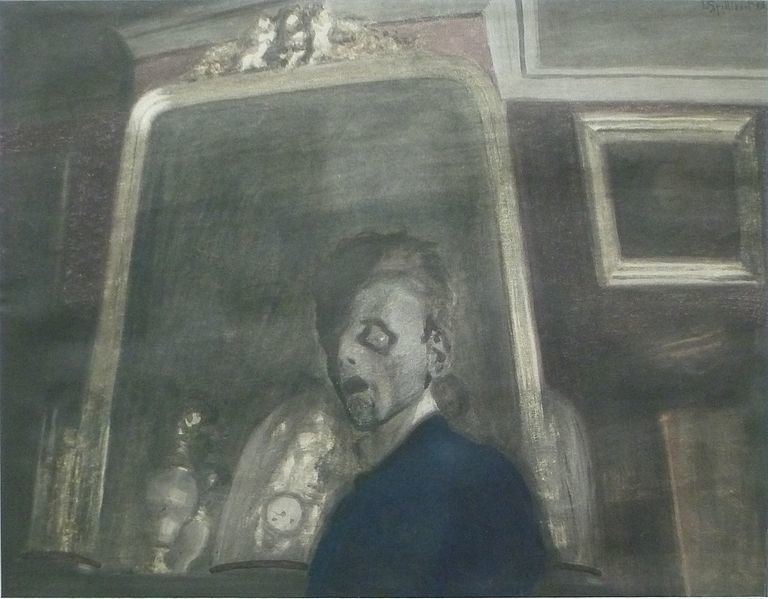 Self-portrait with mirror, 1908, Mu.ZEE, Ostend
Self-portrait with mirror, 1908, Mu.ZEE, Ostend© Wikimedia Commons
In Self Portrait with Mirror, of 1908, the only colour which relieves the black, white and grey scheme is the faintly glimmering yellow that defines the frame of the mirror enclosing Spilliaert’s spectral head and shoulders and also the clock that serves here as a reminder that the passing of each moment brings death closer. As Andrew Marvell wrote: ‘At my back 1 always hear time’s winged chariot hurrying near’. Indeed, at the centre of this shadowy composition the artist’s head is caught in a spasm of terror. Does he actually see or hear death? The picture frame to the right contains no painting, only a black emptiness. Does that indicate that we have already moved out of the world of the living?
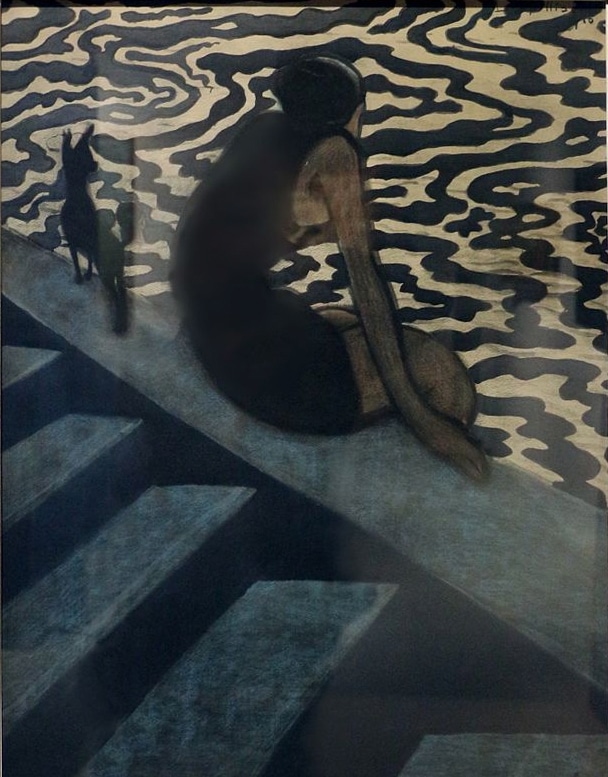 Sitting Bather, 1910, Royal Museums of Fine Arts, Brussels
Sitting Bather, 1910, Royal Museums of Fine Arts, Brussels© Wikimedia Commons
One of Spilliaert’s most memorable images of a solitary figure is Sitting Bather, of 1910. Here the waves of the sea, represented by irreal arabesques, in the upper right part of the transversal composition, are strongly contrasted with the geometry of the steps in the sea wall to the lower left. Complexity is added by the tension between the downward thrust of the parapet and the counter-thrust, at right angles, of the steps. Indifferent to this compositional game, a girl in bathing costume and cap sits with her back to us, looking down at the curvilinear lines of the waves. Like his mistress, a little dog also fixes his gaze on the sea.
The coupling of perspectival geometry and arabesque in Sitting Bather is, compositionally, one degree more sophisticated than the purely geometric structure of Woman on the Dike (1908), but this water-colour is nevertheless Spilliaert at his most convincing. Six coloured triangular strips, pushing upwards, converge at the end of a sea wall. Perspectival geometry, as often in Spilliaert, is taken to the limits of figuration, to the verge of abstraction. Above, two horizontal bands of blue absorb the shock of the rising triangles. Alone, isolated on the sea wall, stands a white-shawled, black-skirted woman who, like the Bather, rejects all communication with the viewer, engaging in a mysterious interplay with her Ostend seafront setting. No influence here, but parallels with the patterned compositions of Felix Vallotton and the anguished loners of Edvard Munch.
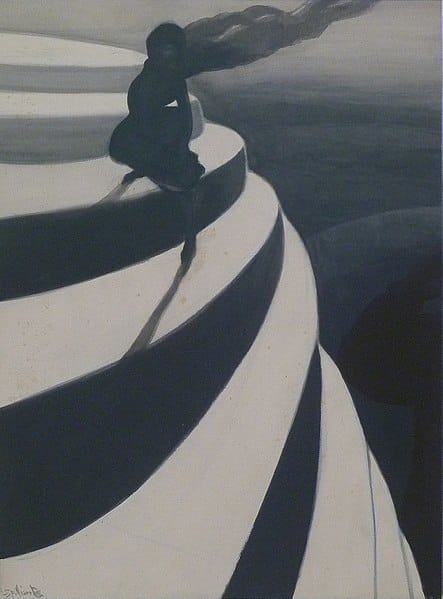 Vertigo, 1908, Mu.ZEE, Ostend
Vertigo, 1908, Mu.ZEE, Ostend© Wikimedia Commons
The parallel with Munch is even more evident in Vertigo (1908). But in this black-and-white study the figure of the woman is closer to symbolist imagery of vampires, witches and femmes fatales than to the statuesque bather and fisherwoman in the two paintings discussed above. Precariously poised on the steep steps of a conical tower, unbalanced, legs akimbo, hair flowing, will she fall or throw herself into the dark void that awaits her under the steeply plunging steps? Despite the painter’s success in constructing his pictorial structure from the series of steps, the woman is not totally absorbed into the composition as are the figures of the Bather and the fisherwoman. Here the woman’s emotion cries out to us from the picture. She tries to free herself from the perils of her predicament. In the two other paintings the women are integrated, synthesised into the space in which the artist encloses them.
Spilliaert’s view of people was not only a vision of isolated ‘psycho’ women. He began a process of celebrating the life and work of fishermen and fisherwomen by monumentalising them – a process that Constant Permeke was to continue and carry through to its logical conclusion in his massive silhouettes of stylised workers, both fishermen and peasants. In a number of paintings, too, Spilliaert treated young girls in Nabi style. Of these, The Girls with the White Stockings (i912) is perhaps the most relaxed and charming. In a densely organised picture five schoolgirls are presented in a decorative pattern. The pigtailed girls, who turn away from us, are reduced to completely flat decorative areas of colour (muted blue and green, ochre and black, heightened by the ‘cut-out’ legs in white stockings). There is no drawing, no perspective, the whole painting being built up from blocks of colour. Here, as so often in his painting, Spilliaert’s use of colour is not descriptive but decorative and expressive.
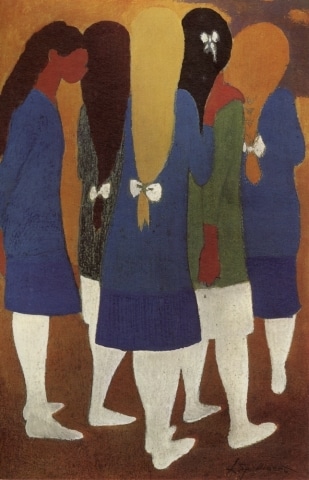 The Girls with the White Stockings. 1912, Mu.ZEE, Ostend
The Girls with the White Stockings. 1912, Mu.ZEE, OstendSimilar in some ways to The Girls with the White Stockings is a religious piece, Pieta, of 1910. There is a comparable merging of the figures into an overall grouping of the actors in the Passion drama, though here it is difficult to distinguish the form of Mary Magdalene from the body of the dead Christ, obscured behind her. Further back two black-robed figures – the Virgin Mary and Saint John? – stand in attitudes of grief, but depersonalised since we cannot see their downcast faces. The schematic background suggests an Ostend beach and a grey-green North Sea rather than the hill of Calvary or the city of Jerusalem. Christ’s corpse is a sinuous yellow form that holds the pictorial structure together like one of those S-shaped bodies beloved of Rubens. Once again, the colour is not realistic but emotive.
Spilliaert was able to endow inanimate objects with a strange life of their own. In that respect, he was a precursor of Rene Magritte, who was to write that his art was concerned with ‘the inherent poetry and mystery’ of the objects he painted: ‘my conception of painting … is to accord to objects their full value as objects’.
Such an attitude underlies Spilliaert’s treatment of the cardboard boxes he recorded in his father’s shop and of his father’s perfume flasks.
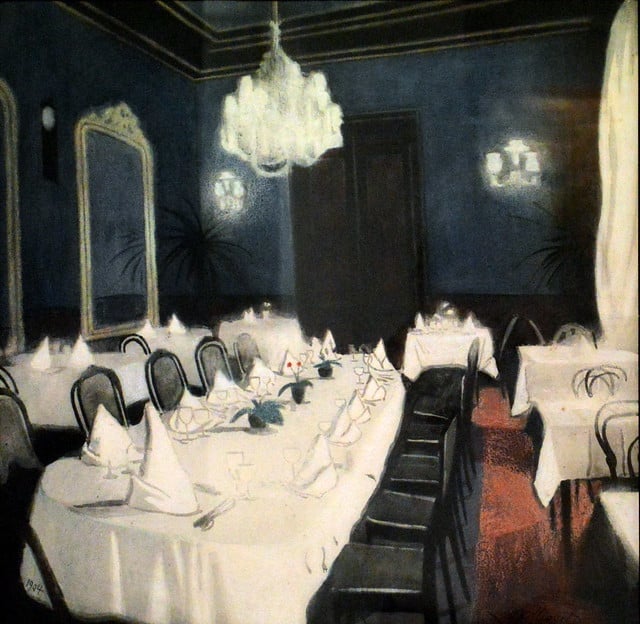 The Restaurant, 1904, Royal Museums of Fine Arts, Brussels
The Restaurant, 1904, Royal Museums of Fine Arts, BrusselsIn The Restaurant (1904), Spilliaert takes as his theme the whole interior of an empty restaurant. No guests, no waiters disturb the mysterious silence of this deserted room. A ghostly light is given off by the freshly ironed tablecloths and the neatly folded napkins, as it is by the chandelier and the bracket lamps on the walls – all in white. All is anticipation. We – like the room – await the arrival of the guests who will never come, never push open the dark doors, never cast their reflections onto the vacant mirror. This unquiet, disturbing image is concerned more with l’attente than with tables, chairs and decor.
As he grew older Spilliaert became increasingly fascinated by the landscape of the lonely region of the Fagnes (in the Belgian province of Liège), and also by trees. His paintings of trees are, broadly, of two distinct kinds. First, pictures in which the bare branches, traced in dark colours, intertwine against a background of clear sky. Second, in his last years, clusters of tree trunks, bare, or almost bare, of branches, which are grouped like the great columns of Romanesque or Gothic cathedrals. Beech Stumps (1945), is a typical example. It is sometimes suggested that these late tree pictures, from which people are conspicuously absent, represent a world-weary rejection of humanity. Although there is, indeed, a somewhat ‘withered’ atmosphere in these treescapes, it would be simplistic, in dealing with so complex a person as Spilliaert, to insist too emphatically on an interpretation of this kind.
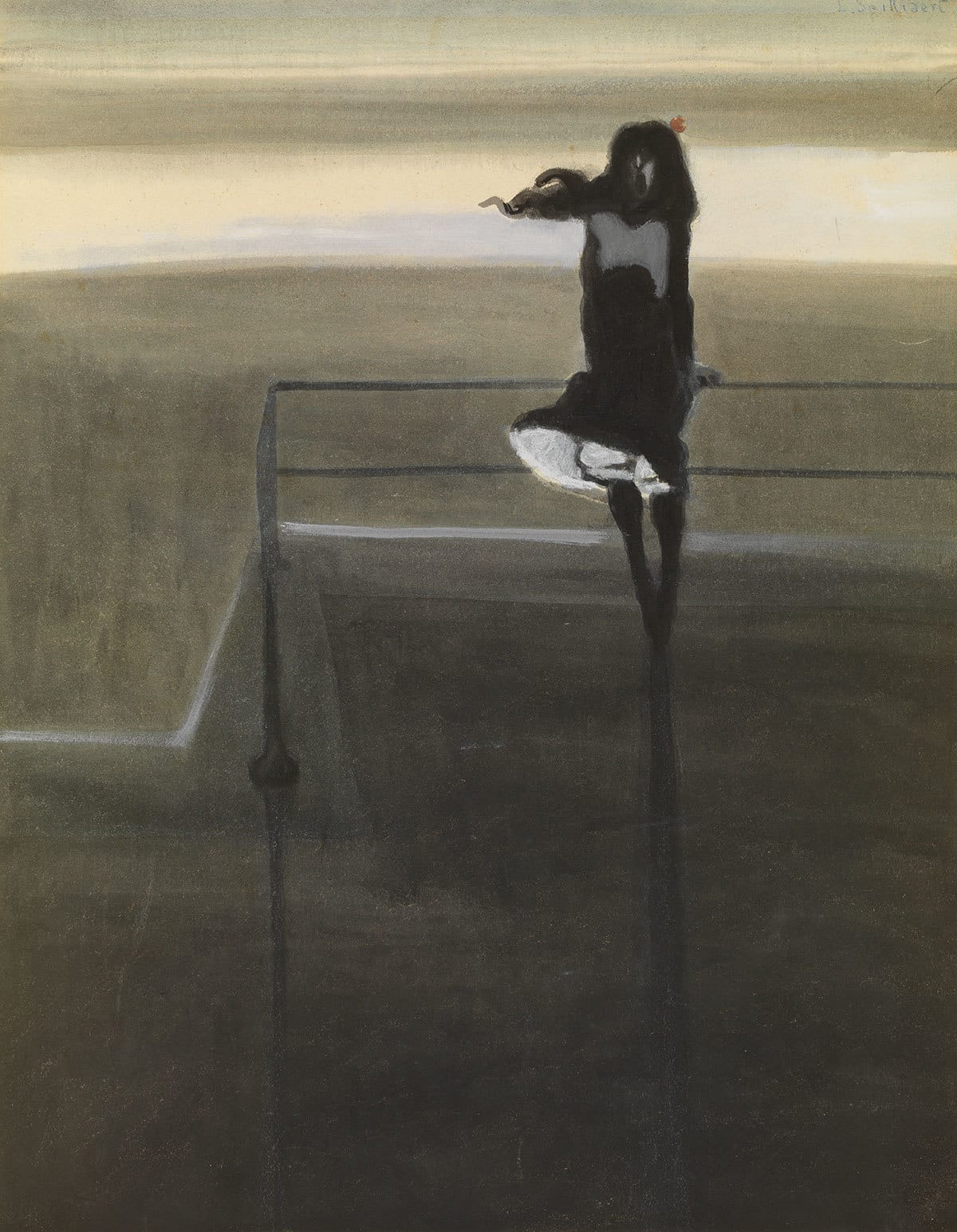 The Gust of Wind, 1904, Mu.ZEE, Ostend
The Gust of Wind, 1904, Mu.ZEE, Ostend© www.lukasweb.be - Art in Flanders vzw. Photo: Hugo Maertens
A brief look at a random selection of works by Leon Spilliaert could give the very misleading impression that he had a ready-made artistic recipe which he applied indiscriminately. A handful of Japanese arabesques, a dash of Art Nouveau patterning, a touch of geometric simplification and a few grains of symbolist malaise. All these elements are present in his work, and many others besides. Indeed, according to his friend Henri Vandeputte, his work numbered ‘one thousand, one hundred and ninety-seven different facets’. But far from dominating Spilliaert’s work, these facets made significant but subordinate contributions to the art of the troubled and troubling painter who was able to synthesise subject matter, technique, composition and mood into a uniquely personal vision. It was, as Fernand Crommelynck wrote in 1908, essentially Spilliaert’s gift for pictorial synthesis that set him apart from other painters: ‘Leon Spilliaert possesses, to a higher degree than any painter of our time, the gift of synthesis.’











